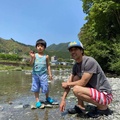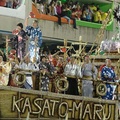Los Angeles has long been a gateway between Japan and the United States. It started over one hundred years ago when the first Issei landed on the California coast in search of better opportunities and continues today with Japanese businessmen and their families flying into LAX.
The recent Japan Expo, now in its 28th year, held at the Los Angeles Convention Center is a prime example of the transmission of Japanese culture. Visitors enjoyed a wide variety of booths offering traditional and modern Japanese arts and crafts on display. There were vendors who offered gifts, housewares and other unique Japanese products for sale. On the main stage, the lineup included Japanese dance performances and music concerts. This year's special guests were the virtuoso shamisen duo, the Yoshida Brothers and a puppet master, Jusaburo Tsujimura, who entertained the crowd by bringing a doll dressed in kimono to life with an elegant dance. For the thousands of visitors to the Japan Expo, both Japanese and American, the event was a one-stop destination to absorb all that Japan has to offer without the jet lag.
Check the video of Chindon-ya street performers at the Japan Expo: http://www.youtube.com/watch?v=_p6N4pRvnew
But among all the festivities, where were the Nikkei?
People who were born in Japan and now reside in Los Angeles still identify strongly with their homeland and make an effort to maintain their cultural identity through language, food, customs and traditions. These people, not American-born Japanese, are largely the organizers of the Japan Expo. And so, as an event, the Japan Expo is able to meet its goal of promoting Japanese culture and building stronger ties between Japan and America. But as for the Nikkei, who were born in America and were raised with American values and culture, they do not share the same goals as the Japan Expo organizers.
Nikkei ties to Japan are primarily familial ones. Visits to Bachan and Jichan are when Japanese customs like walking indoors shoeless or eating with chopsticks are practiced, but once the family returns to their suburban home, life reverts back to shoes and forks. Customs, as well as values, language and food must be passed down from one generation to the next or else they are lost.
As the older generations pass on, many Nikkei, now reaching the fourth and fifth generations, have lost their family ties to the old country. And while we all want to think we come from a long line of samurai, many of us don't know our own family histories or even how to write our names in kanji.
This raises even more questions. Is it even important for Nikkei to maintain a Japanese cultural identity? And at what point do Nikkei become completely assimilated? As individuals, we must decide for ourselves. Embracing one's heritage can be expressed in a variety of ways or sometimes not at all. It's a matter of choice for how we want to be self-actualized.
But as a community, Japanese Americans need to maintain a cultural identity, one that is linked to Japan. For one thing, we are a minority in the United States. As people of Asian descent, our claims as Americans will always be challenged no matter how "Americanized" we become. Rather than shed our cultural identity, it should be embraced because it is through diversity and tolerance that we can truly be a part of the American fabric. However, this does not mean that we need to become more Japanese, I am only saying that we need to know where we come from and strive to maintain some key traditions.
Historically, Japanese Americans on the West Coast faced a tough task as a community after World War II to form an identity. The Nisei were placed in camps because of blood ties and the color of their skin even though they were citizens by birth. So holding on to Japanese customs and traditions did not bear merit in an anti-Japanese post war atmosphere.
But some traditions did persevere within the Nikkei community like the Nisei Week parade and festival in Los Angeles' Little Tokyo. For years after the war, Nisei Week flourished because the community was strong and people were connected to each other through family and personal relationships, business ties, churches, schools and other organizations. It also helped that Japanese Americans were clustered together, living in pocket neighborhoods around Los Angeles. The most important aspect of this yearly community celebration was that traditions were reinforced and passed on.
But as time passed on, the community waned. People moved away, ties were stretched and eventually broken. New traditions replaced the old. Year by year, Nisei Week held less significance and the crowds became smaller as families stopped coming to Little Tokyo. Without tradition, Japanese American cultural identity is endangered and Nisei Week is quickly fading into a memory.
Without the new generation of Japanese immigrants, customs and traditions might be completely lost to many Nikkei. The sensei of the traditional arts like ikebana and kendo are typically from Japan. Japanese immigrants have opened grocery stores and restaurants to eat the dishes that they grew up with. And when it comes to language retention, just as the original Issei started newspapers in Japanese to keep up with events back home, the new generation has Japanese television programming via satellite for up-to-the-minute sports scores and the latest political scandals. These "Shin-Issei" not only bridge Japan and America, they can also be the bridge for us Nikkei and our own cultural identity.
Nebuta float at the 2007 Nisei Week parade.
The participation of this float from Aomori, Japan was arranged by members of the Japanese community living in Los Angeles. This is an example of how Shin-Issei can help bring crowds back to Nisei Week.
The involvement of the Shin-Issei community is important to the future of Nisei Week. Perhaps the Japan Expo, an event that is not a festival, could join forces with Nisei Week to create a dynamic tradition that everyone can enjoy. By forging stronger ties with the Japanese community, Nikkei can reclaim their heritage. Now that's something worth celebrating.
© 2007 Bobby Okinaka





